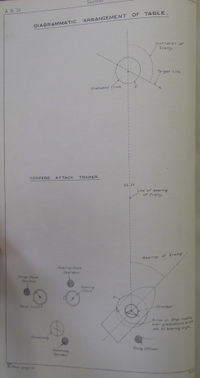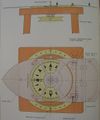Difference between revisions of "Torpedo Attack Table"
| Line 11: | Line 11: | ||
The "target fleet" would be small models or cut-outs of ships of approximately 150 feet to the inch, arranged 500 yards apart along a wooden batten 42 inches in length and able to revolve around a fixed, graduated disc marked to show inclination of the batten as seen from "own ship". A painted sky and sea surface concealing the batten would provide a fairly clean view to the man at the torpedo director. | The "target fleet" would be small models or cut-outs of ships of approximately 150 feet to the inch, arranged 500 yards apart along a wooden batten 42 inches in length and able to revolve around a fixed, graduated disc marked to show inclination of the batten as seen from "own ship". A painted sky and sea surface concealing the batten would provide a fairly clean view to the man at the torpedo director. | ||
| − | + | The man being tested would man the torpedo director and four assistants would manage the simulated attack, using | |
| + | * a [[Dumaresq]] (fitted so enemy heading can be set by inclination, a Mark IV being preferred<ref>''Handbook of Torpedo Control, 1916'', p. 91</ref>) | ||
| + | * an [[Elliott Range Keeper Mark III]]<ref>''Handbook of Torpedo Control, 1916'', p. 91</ref> (being pressed into service as a bearing clock -- if none were available, a second Vickers clock could be used despite less convenient markings) | ||
| + | * a [[Vickers Range Clock]] | ||
| + | * a stopwatch | ||
The officer in charge would specify enemy's inclination, bearing, range and speed, as well as own speed. The dumaresq operator would set inclination, bearing, and the two speeds on his instrument, and the Vickers clock man would put the range on his clock as well as the range rate provided him by the dumaresq number. The Elliott clock man sets the bearing on his device, 100 yards being treated as 1 degree. The dumaresq man (or, preferably, the Elliott man) converts the indicated [[Dumaresq Deflection]] to a [[Bearing Rate|bearing rate]] by use of a table, and the Elliott man applies this as his rate using the same 100 yards equals 1 degree conversion. Lastly, "Own ship" is swung to the enemy bearing, the target fleet's inclination is set as specified, and the run is ready to begin. | The officer in charge would specify enemy's inclination, bearing, range and speed, as well as own speed. The dumaresq operator would set inclination, bearing, and the two speeds on his instrument, and the Vickers clock man would put the range on his clock as well as the range rate provided him by the dumaresq number. The Elliott clock man sets the bearing on his device, 100 yards being treated as 1 degree. The dumaresq man (or, preferably, the Elliott man) converts the indicated [[Dumaresq Deflection]] to a [[Bearing Rate|bearing rate]] by use of a table, and the Elliott man applies this as his rate using the same 100 yards equals 1 degree conversion. Lastly, "Own ship" is swung to the enemy bearing, the target fleet's inclination is set as specified, and the run is ready to begin. | ||
Revision as of 14:50, 13 March 2011
The Torpedo Attack Table was a Torpedo Control teaching aid to practice torpedo attacks.
It was described in the Annual Report of the Torpedo School, 1915[2] as a "Torpedo Attack Trainer", similar the Gunnery Spotting Table. It was a "play at home" edition of torpedo attack, requiring a fairly large open area, with the model "firing ship" with a Torpedo Director mounted on it and the model "target fleet" being about 25 feet from each other. It was to be a casual affair "very easily made in the ship."
Initial Design
The trainer was to have comical little "own ship" cut from wood and able to revolve atop a fixed wooden compass disc 16 inches in diameter and marked 0 to 180 degrees. A pointer on the ship would indicate against this scale, and a torpedo director would be mounted on the toy ship. If it is desired to practice for trainable tubes, the director could also be allowed to train over the ship.
The "target fleet" would be small models or cut-outs of ships of approximately 150 feet to the inch, arranged 500 yards apart along a wooden batten 42 inches in length and able to revolve around a fixed, graduated disc marked to show inclination of the batten as seen from "own ship". A painted sky and sea surface concealing the batten would provide a fairly clean view to the man at the torpedo director.
The man being tested would man the torpedo director and four assistants would manage the simulated attack, using
- a Dumaresq (fitted so enemy heading can be set by inclination, a Mark IV being preferred[3])
- an Elliott Range Keeper Mark III[4] (being pressed into service as a bearing clock -- if none were available, a second Vickers clock could be used despite less convenient markings)
- a Vickers Range Clock
- a stopwatch
The officer in charge would specify enemy's inclination, bearing, range and speed, as well as own speed. The dumaresq operator would set inclination, bearing, and the two speeds on his instrument, and the Vickers clock man would put the range on his clock as well as the range rate provided him by the dumaresq number. The Elliott clock man sets the bearing on his device, 100 yards being treated as 1 degree. The dumaresq man (or, preferably, the Elliott man) converts the indicated Dumaresq Deflection to a bearing rate by use of a table, and the Elliott man applies this as his rate using the same 100 yards equals 1 degree conversion. Lastly, "Own ship" is swung to the enemy bearing, the target fleet's inclination is set as specified, and the run is ready to begin.
The clocks and the stop watch are started. The range is periodically read off the Vickers clock for the firing officer to hear, and available hands spin "own ship" to the new bearing every so often, according to the Elliott's indications. The range rate and bearing rate is modified on the clocks as the bearing changes, and the inclination of the enemy can also be applied from the dumaresq. The firing officer being tested can set his director's enemy heading and can choose to command a turn which alters the bearing on "own ship" and the dumaresq and Elliott to suit.
When the firing officer wants to fire, he calls it out (perhaps soon after training his tube or ordering a course change to bring sights on). The stopwatch and both clocks are stopped and the result of the shot plotted visually.
Final Design and Deployment
By mid 1919, twenty units of the approved design were being manufactured for allocation as follows: three to H.M.S. Vernon (Torpedo Training School)|Vernon]], two each to Port Edgar and Lyness depot bases, and one each to Immingham depot base, Dover depot base, Defiance, and depot ships Actaeon, Apollo, Woolwich, Blake, Diligence, Greenock, Sandhurst, Hecla, Dido and Blenheim.[8]
Each table was to be accompanied by a T.D.S. Mark III and a Pattern 36 signalmen's instructional box.[9]
[TO BE CONTINUED - TONE] ARTS 1918 p 227-8 onward
See Also
Footnotes
- ↑ Annual Report of the Torpedo School, 1915, Plate 9.
- ↑ Annual Report of the Torpedo School, 1915, p.53
- ↑ Handbook of Torpedo Control, 1916, p. 91
- ↑ Handbook of Torpedo Control, 1916, p. 91
- ↑ Annual Report of the Torpedo School, 1918, Plate 144.
- ↑ Annual Report of the Torpedo School, 1918, Plate 145.
- ↑ Annual Report of the Torpedo School, 1918, Plate 146.
- ↑ Annual Report of the Torpedo School, 1918, p. 227.
- ↑ Annual Report of the Torpedo School, 1918, p. 228. (A.L.G. 10951/18)
Bibliography
- Template:BibUKARTS1915
- Template:BibUKHandbookOfTorpedoControl1916
- Template:BibUKARTS1917
- Template:BibUKARTS1918



